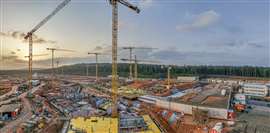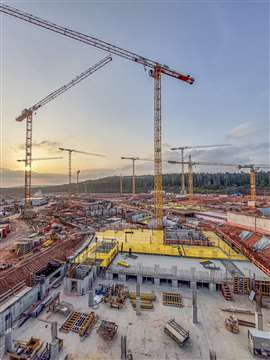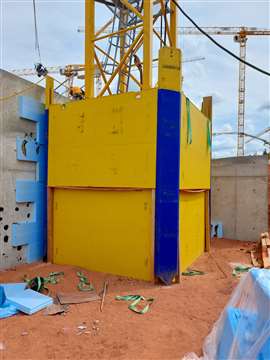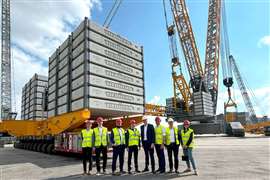Read this article in Français Deutsch Italiano Português Español
Hospital job for more than a dozen Wolff tower cranes
07 February 2024
 A total of 13 Wolff tower cranes are helping to build the new 4,000 room hospital in Germany
A total of 13 Wolff tower cranes are helping to build the new 4,000 room hospital in Germany
Tower crane manufacturer Wolffkran diagnosed and prescribed solutions for a series of challenges on a hospital construction project in Germany.
Military and other parameters added up to a multiplicity of requirements for the tower crane manufacturer and rental company Wolffkran on the 13 crane site in Germany. The project is to construct what will be the largest US military hospital outside the USA. Being built close to the Ramstein air base near Kaiserslautern it will replace the US Army hospital built in 1953 in nearby Landstuhl.
In the new hospital there will be more than 4,000 rooms, 120 treatment rooms, and nine operating theatres covering a total of around 90,000 square metres. It is being built by ARGE US-Klinikum Weilerbach, a construction consortium consisting of Ed. Züblin AG and Gilbane.
“Even before the crane foundations could be planned, numerous bureaucratic hurdles had to be overcome,” said work planner Daniel Rüttinger, responsible for process planning and construction operations at Ed. Züblin.
Aerial interference
 Aviation permits were required for the cranes as the site sits in the flightpath of the Ramstein airbase
Aviation permits were required for the cranes as the site sits in the flightpath of the Ramstein airbase
With the project sitting directly on the flight path of Ramstein Airbase the site, plus mobile cranes there, needed aviation permits from the German Armed Forces Aviation Office. Special lighting also had to be fitted.
Ground conditions presented another challenge. “Due to the highly heterogeneous subsoil, consisting of several soil layers, exploratory drilling was carried out at each crane site,” explained Daniel Rüttinger.
Buoyancy created by rising groundwater and underground pipes had to be factored in to the foundation design. A further consideration was the compatibility of the concrete for the foundations with naturally occurring radon in the ground.
To give the cranes full coverage of the site some of them had to be positioned low in the ground. These had foundations up to 2.4 metres high and shoring around the lower tower sections so the tower could be completely removed at the end of the job.
 Shoring was put around some of the cranes that were set at a low level on the site. Photo: Wolffkran
Shoring was put around some of the cranes that were set at a low level on the site. Photo: Wolffkran
The Wolff cranes on site are a mix of new and old, including an 8033.16 Cross, a 7534.16 Clear, a 7032.12 Clear, three each 6031.12 Clear and 6031.8 Clear models, two 5014.6 City, a 262 SL and a 6522 FL 12. Lifting capacities are between 6 and 16.5 tonnes and tip loads from 1.8 to 7 tonnes. Five of the cranes have 65 metre jibs and the shortest is 42.5 metres. Tower heights for the tallest cranes reach 70 metres.
Züblin supplied ten of the cranes, three of which were newly acquired for this job. At the other end of the age range on site is the rental company’s 262 SL built in 1989 and in the fleet for 34 years.
In addition to moving and placing formwork and rebar, the cranes are handling staircases and other precast concrete elements.
STAY CONNECTED


Receive the information you need when you need it through our world-leading magazines, newsletters and daily briefings.
CONNECT WITH THE TEAM












